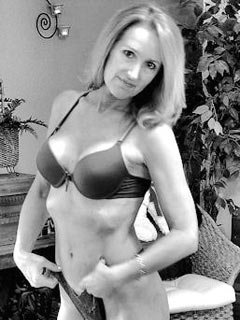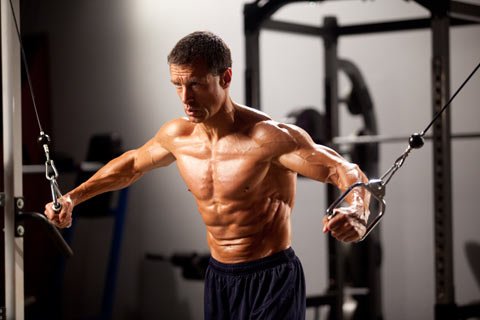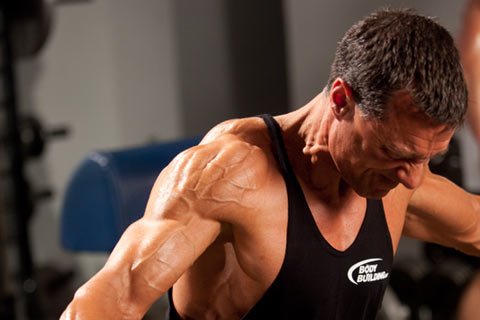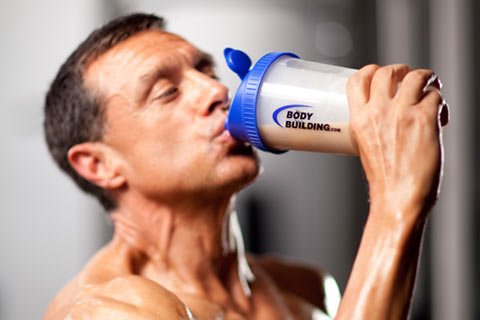| Article Summary: |
In part one, Fitness Success After Forty: Know Your Body Type, we learned about how the three different body types affect how you train and gain muscle. Now that you know your body type, you need to know a few basic elements that are involved with adding lean mass.
In Fitness Success After Forty, Part Two: Muscle Building Basics, Sue Wilkerson will give you insight into how muscles grow and what to expect when embarking on a muscle-building journey.

Fitness Success After 40
Part 2: Muscle Building Basics!
When embarking on a muscle-building endeavor there is much to learn. Ask any long time bodybuilder how long it took them to learn it all and they will tell you they are still learning. Much of what we learn is from the physical act of doing; as with anything we undertake, trial and error can be the best teacher.
You can, however, get a leg up on the learning curve by educating yourself on the basics of muscle physiology and how it applies to the amateur bodybuilder, or anyone wishing to firm, tone or build more lean mass.
Following is a primer which will walk you through the five fundamentals and give you a heads-up on what to expect and how to get the most bang for your buck when it comes to working out.
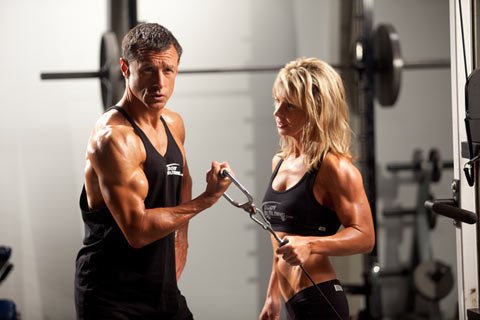
 Click To Enlarge.
Click To Enlarge.
These Five Fundamentals Will Give You A Heads-Up
On What To Expect When It Comes To Working Out.

1. The Burn
No doubt you've heard the phrase "Feel the burn." But do you know what causes that burning feeling in the muscles?
When you are working a muscle, for instance while doing a dumbbell bicep curl, as you get to your failure point your muscle has depleted its oxygen and will start to release lactate, which it then uses for energy.
Lactate is an acid, which causes a burning feeling in the muscles. The burning feeling will subside during your between-set rests, peak sooner with each progressive set, and be gone from your muscles within an hour of exercise.
Many people in sports believe that "the burn" is counterproductive to muscle growth. But research has proven the opposite to be true.
According to exercise physiologist George Brooks, UC Berkeley Professor of Integrative Biology, training teaches the body to efficiently use lactic acid as a source of fuel on par with the carbohydrates stored in muscle tissue and the sugar in blood. Efficient use of lactic acid, or lactate, not only prevents lactate build-up, but also creates more energy from the body's fuel.
So when you feel the burn, don't despair. It doesn't mean you're weak or unable to make progress. It is simply your body signaling you that your muscle has reached its threshold and needs to rest. Best of all, with time and dedicated training, your threshold will increase, allowing you to lift heavier and/or do more reps before the burn kicks in.
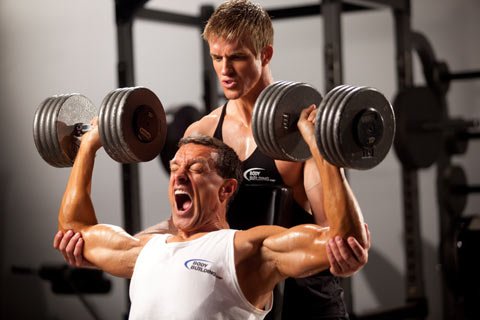
 Click To Enlarge.
Click To Enlarge.
Don't Worry If You Feel The Burn. It Is Simply Your
Body Signaling You That It Needs To Rest.

2. Muscle Growth
Muscle growth is somewhat complicated and often misunderstood. But there is one undisputed fact when it comes to muscle growth: the only way to build a muscle is to injure it. When you work a muscle properly and challenge it, you are causing trauma to the muscle fibers.
In turn, this stimulates satellite cells which lay outside the fibers to start repairing these injured fibers. These satellite cells fuse together along with the muscle fibers, causing hypertrophy, or muscle growth.
The satellite cells have only one nucleus and replicate themselves by dividing. As they multiply, some remain as organelles (a part of a cell) on the muscle fiber. But most will differentiate (the process cells undergo as they mature into normal cells) and fuse to muscle fibers to form new muscle myofibrils in their effort to repair damaged fibers. In turn, the muscle cells' myofibrils will increase in thickness and number. Voilà! You have just stimulated your muscles to grow larger.
Keep in mind however, that this damage is microscopic, so it is going to take repeated injury to see noticeable muscle gains. Also, as we age, the repair period and the forming of new myofibrils may be affected due to decreasing hormone levels.
After a work-out, increased soreness, or no soreness at all doesn't necessarily mean you did too much or not enough. Muscles can react differently to training, sometimes for no apparent reason. The main thing to remember is that moderate soreness means your muscles are doing precisely what you want them to do.

3. Delayed Onset Muscle Soreness
Yet another phrase from the past, "No pain, no gain," was founded in truth rather than fiction.
I vividly recall trying to get my Mom to exercise. "I can't," she'd say. "It makes me hurt." Precisely. Not that you should hurt so much that you can't get out of bed, or go to work, but the muscle soreness we examined in number two on this list is a sign of muscle growth.
This soreness doesn't happen instantaneously. Labeled Delayed Onset Muscle Soreness, or DOMS, the word Delayed is due to the lapse in time between the actual damage to the muscle fibers and the point in which a signal is sent to your brain that they have in fact been injured.
While many people believe that the muscle soreness (i.e. pain) they feel is from the muscle itself, research claims that the pain of DOMS is not caused by the damaged muscle cells alone, but from the repairing process.
This process causes the cells to swell in their compartment and put pressure on nerves and arteries, producing pain. There is logic to this; let's say you have sore pecs and someone comes up and pokes you. The area is tender from right under the skin all the way down deep into the muscles.
Some trainers recommend stretching after your work out as a means to lessen the DOMS, but there are mixed schools of thought on this and there is no solid research indicating that the level or length of the soreness will be lessened.
| RELATED POLL | |||
|
|||

4. Rest Your Weary Muscles
Arnold used to say that he believed that his muscles were growing while he was working (more like torturing) them. More than likely he was just enjoying a massive pump combined with the release of lactate and it indeed felt like the muscles were growing right before his very eyes.
In reality, muscles aren't capable of growing while you are traumatizing them...that would be like trying to do body and fender work to your car in the middle of an accident. Somehow it just doesn't seem likely. As discussed above, muscles grow when they are repairing themselves, and this process takes place while the muscles are resting.
There have been studies conducted which conclude that an injured muscle fiber takes from five to seven days to repair itself. While that may be true, I can honestly say I have never known anyone who remains sore seven days after even the most intense work out.
| RELATED POLL | |||
|
|||
However, research has proven beyond a shadow of a doubt that rest is imperative to muscle growth. Picture those poor little worker satellite cells frantically rushing around rebuilding the structure that you just put through an earthquake. They need energy to accomplish their work, and if you are tired and have no energy, neither will your cells.
Additionally, our muscles need growth hormone to aid in their development. Growth hormone is a chemical substance produced in the pituitary gland that, along with the thyroid hormone, supports proper growth, development, and repair in our bodies.
The major role of growth hormone in stimulating body growth is to stimulate the liver and other tissues to secrete IGF-I. IGF-I stimulates proliferation of chondrocytes (cartilage cells), resulting in bone growth. IGF-I also appears to be the key player in muscle growth. It stimulates both the differentiation and proliferation of myoblasts. It also stimulates amino acid uptake and protein synthesis in muscle and other tissues.
In short, your muscles need rest to grow. A safe rule of thumb is to get seven to eight hours of good sleep at night, take at least two days off per week from working out and rest three to four days between working the same muscle group. If a muscle group is still sore, do not exert it until the soreness has passed.

5. Feed Your Hungry Muscles
Now that we've covered the physical aspect of muscle building, we need to touch on one more very important topic: feeding your muscles. Muscles, when in growth mode, are very hungry little critters. And like a growing teenage boy, the bigger they get the hungrier they are.
Now if you struggle with your weight, you may be sighing heavily right now. Hungrier than I already am? Are you kidding?
The good-no, great-news is that you can feed your beastly muscles in great quantities and they in turn will not only grow, but help you slay the fat monster. You probably already know that past age-forty our metabolism starts to slow and hormones cause us (women especially) to start to accumulate fat around the middle. Having some muscle on your side is a great boost to the war on middle-age spread.
That said, while you must feed your muscles, that does not give you license to chow down on cheeseburgers and chocolate cake. What your muscles need to grow is quality lean protein, nutrient-rich vegetables and whole grains such as brown rice, sweet potatoes and oatmeal.
Your daily protein intake needs to be approximately 1.5 grams of protein per one pound of body weight. That means if you now weigh 180 pounds, you need to consume 240 grams of protein per day. It may not sound like a lot, but compared to the average person's daily consumption, believe me, it is.
For instance, a chicken breast has about 30 grams of protein. A six-ounce steak has about 42. A large egg has six and a cup of milk about eight. So let's say you eat a steak dinner, with a baked potato, salad and dinner rolls. The only food on your plate that is going to supply you with measurable protein is the steak. You may garner a few grams if your salad has some cheese and kidney beans sprinkled in, but they won't account for much.
Then, if you had scrambled eggs, hash browns and toast for breakfast, and a tuna sandwich and pretzels for lunch, followed by a carton of yogurt mid-afternoon, you will still be hovering at the 100 gram mark. Just a bit shy of your requirement, right?
So, how do you get the protein you need? Make sure to have a good portion of each meal come from protein. Learn to read labels and choose foods that are at the higher end of the scale. Black beans, pinto beans and lentils make a great side dish that is fairly high in protein (about 7 -10 grams per cup). Chicken, fish and lean red meat contain high protein counts, and dairy products are also fair sources.
It is virtually impossible to get all the protein your body is going to require from foods. The stopgap is protein supplements. A good quality protein shake made with milk can give you nearly 40 grams of protein. Supplement with two to three of these per day and you should be able to reach your protein requirement. If you are still falling short, snacking on protein bars should do it.
Lastly, consume five to six small meals per day. This will keep your metabolism ramped up as your body will always be burning the calories consumed, and you will be supplying your muscles and organs with a constant flow of protein and nutrients.
|
|
|
|
|
A study published in the American Journal of Clinical Nutrition looked at the effects of regular meal frequency on fat burning (your internal thermostat), insulin sensitivity, and cholesterol in healthy obese women. People who ate small, frequent meals (about six a day) were compared to people who ate less regularly throughout the day.
What they found is that those people who consumed six meals at approximately two-hour intervals had increased thermogenesis.
Thermogenesis is when your metabolism runs hotter and burns more fat. This results from what is called the thermogenic effect of food (the TEF factor). This TEF factor also makes you feel full. It appears to trigger the brain into feeling satisfied and thus reduces your appetite.
So, when you eat small meals throughout the day, you get a slow, steady burn effect from your food. The opposite is true when you binge or eat several huge meals; your body starts storing fat for fuel later on. Trouble is that fat builds up and is hard to lose.
The key here is to control your portions; you don't sit down to five or six huge meals per day. If you did you would gain fat rather than muscle. Your protein shake can be counted as one meal.
A mid-morning snack of an apple, a slice of cheese and a handful of almonds can count as a meal. And when you do sit down to a meal, your protein portion should be the size of your palm and your carbohydrate the size of your fist.
Don't worry too much about calories at this point. As you hone your bodybuilding regimen and gain lean mass, you will adjust the caloric intake accordingly. For now, concentrate on eating a clean diet high in protein, greens and fiber and let your body do the rest.

Conclusion
Let's do a quick review of what you've learned:
- Burning in the muscle is normal and as you strengthen your muscles the burning will lessen.
- Muscle growth requires injuring the muscle fibers, which triggers growth as the repair process takes place.
- You can expect soreness to occur a day or even two after working a muscle group.
- Your muscles need rest during the repair period to grow, and you should never work a muscle group that is still sore.
- You need to feed your growing muscles five or six small, regular meals high in protein and nutrients.
You now have the basic knowledge that will allow you to safely and realistically start training and adding muscle to your physique. Keep these five points in mind throughout your workout regimens--as well as in between workouts--and you will be armed with knowledge that takes some bodybuilders years to learn!
Coming up in Part Three: Supplements That Boost Your Mature Muscle Growth.
Recommended Articles
References:
- Charge, S. B. P., and Rudnicki, M.A. (2004). Cellular and molecular regulation of muscle regeneration. Physiological Reviews, Volume 84, 209-238.
- Foss, M.L. and Keteyian, S.J. (1998). Fox's Physiological Basis for Exercise and Sport. WCB McGraw-Hill.
- Rasmussen, R.B., and Phillips, S.M. (2003). Contractile and Nutritional Regulation of Human Muscle Growth. Exercise and Sport Science Reviews. 31(3):127-131.
- Bowen, R. Growth Hormone (Somatrotropin) http://www.vivo.colostate.edu/hbooks/pathphys/endocrine/hypopit/gh.html,Gr.
- Szymanski, D. (2003). Recommendations for the avoidance of delayed-onset muscle soreness. Strength and Conditioning Journal 23(4): 7-13. Copyright
- Connolly, D. A., Sayers, S. P. & McHugh, M. P. (2003) Treatment and prevention of delayed onset muscle soreness (abstract.) Journal of Strength Conditioning Research, 17(1):197-208.
- Farshchi HR, Taylor MA, Macdonald IA. (2005) Beneficial metabolic effects of regular meal frequency on dietary thermogenesis, insulin sensitivity, and fasting lipid profiles in healthy obese women. Am J Clin Nutr. 2005 Jan;81(1):16-24.
Copyright © Sue Wilkerson 2009
| Share This Article: |

